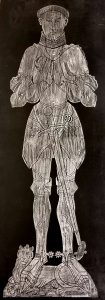Special Collection Spotlight: June Runk Brass Rubbings
 Large rubbings from English Monumental Brasses make up the June Runk Brass Rubbings Collection (M 45). MSU alum June Runk, who lived in Suffolk County, England, from 1972-1976 while her husband served in the U.S. Air Force, created the rubbings. Along with other military wives, she would approach a church vicar and secure permission to make a rubbing of the brasses in a church, sometimes paying a small fee. Mrs. Runk used velveteen paper and a silver or gold wax crayon, taping the paper over the brass, then rubbing the crayon over the paper-covered effigy. She worked four or five hours making each of the larger rubbings. Since 1976, the British government has restricted the making of rubbings because the brasses were becoming too worn.
Large rubbings from English Monumental Brasses make up the June Runk Brass Rubbings Collection (M 45). MSU alum June Runk, who lived in Suffolk County, England, from 1972-1976 while her husband served in the U.S. Air Force, created the rubbings. Along with other military wives, she would approach a church vicar and secure permission to make a rubbing of the brasses in a church, sometimes paying a small fee. Mrs. Runk used velveteen paper and a silver or gold wax crayon, taping the paper over the brass, then rubbing the crayon over the paper-covered effigy. She worked four or five hours making each of the larger rubbings. Since 1976, the British government has restricted the making of rubbings because the brasses were becoming too worn.English Monumental Brasses, a popular means of honoring the dead from 1272 through the late 17th century, are generally grouped in three periods: the first (1272-1399), the second (1399-1509), and the third period (1509-late 17th century). The collection includes rubbings from all three periods: from the first period, two life-size knights; from the second period, 10 dry mounted figures and two rolled; and from the third period, 10 dry mounted figures and three rolled.